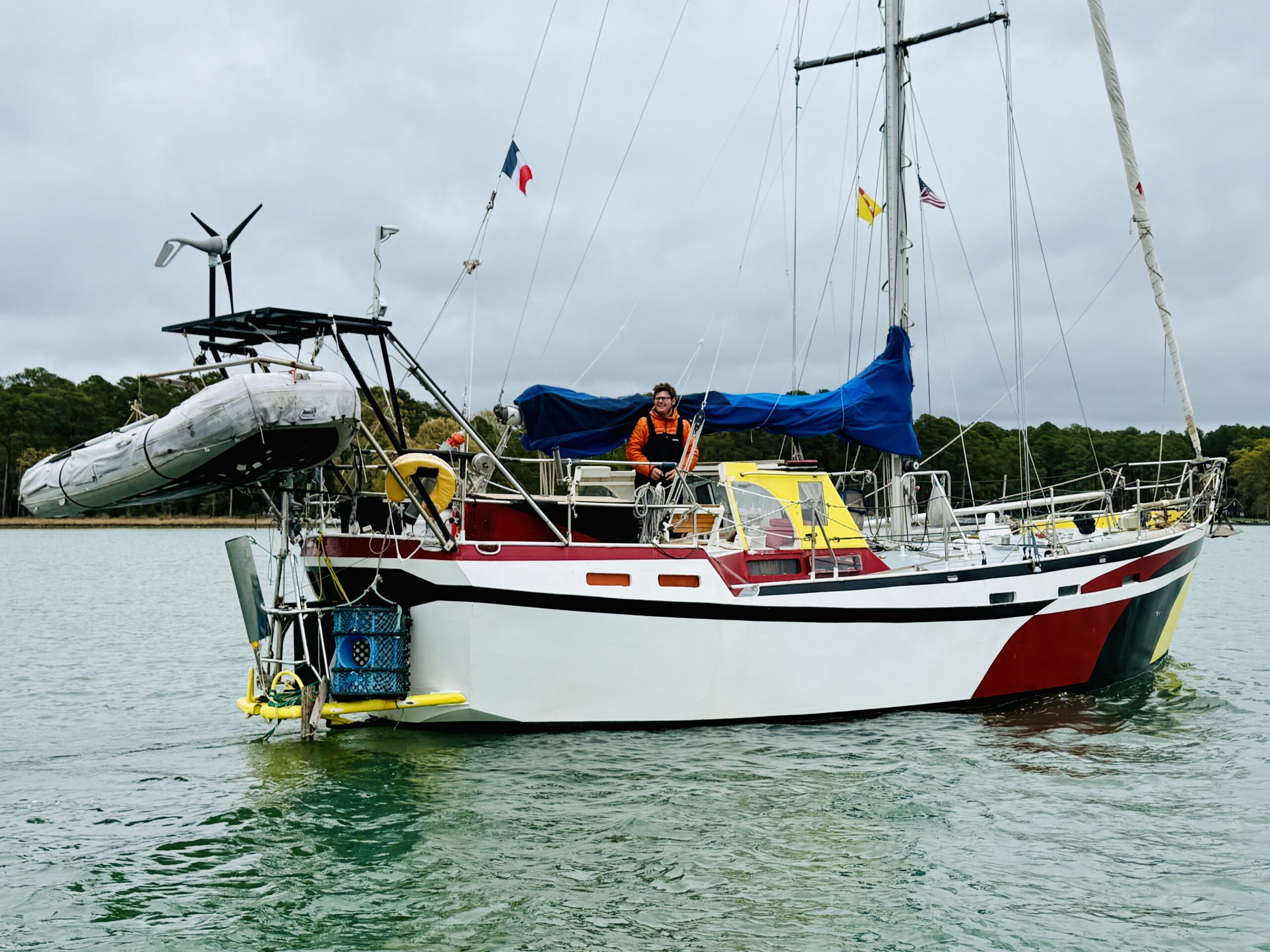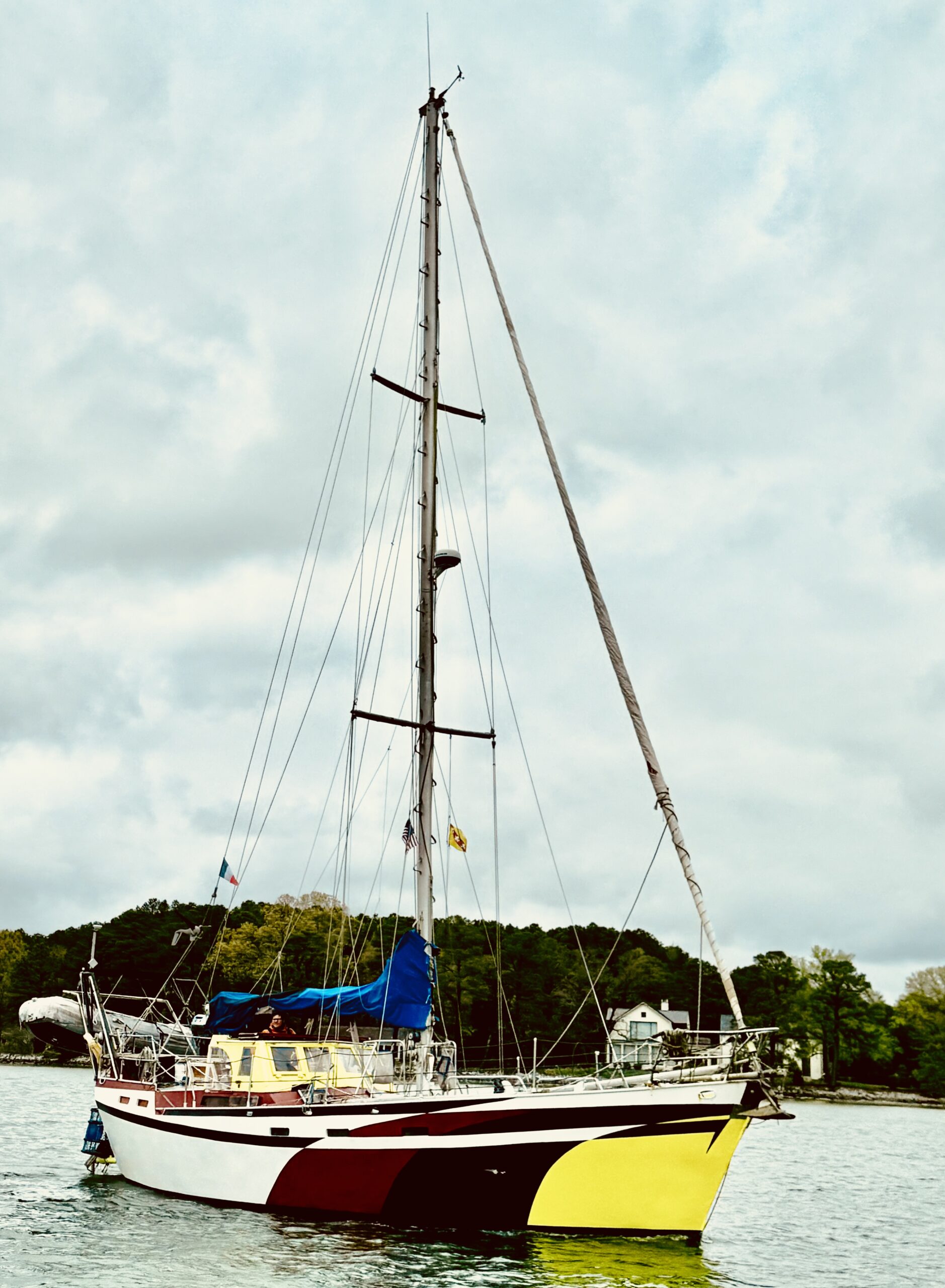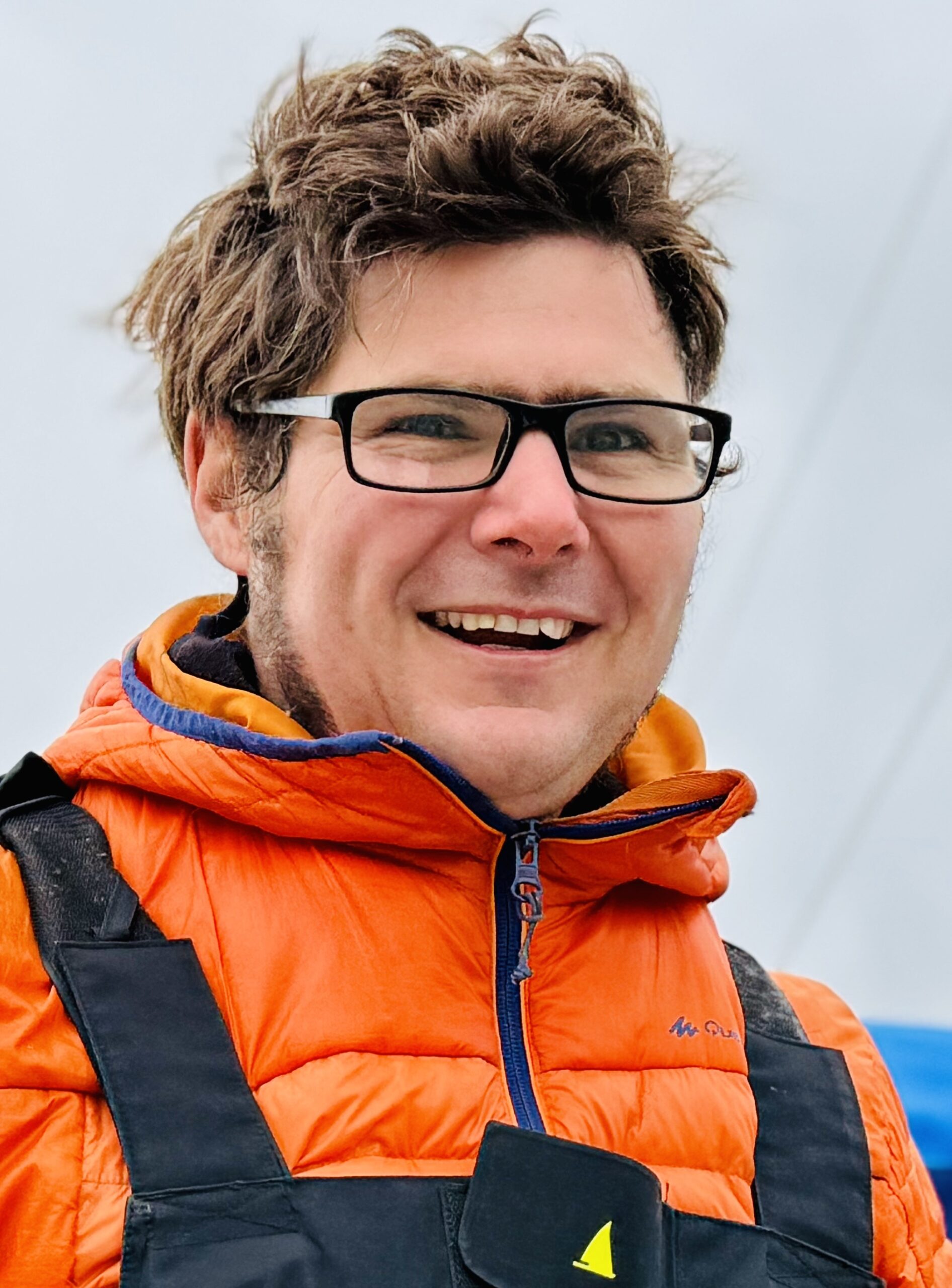
Paladin is fully rigged for sailing the high seas.
His home is in a small town named Metz in eastern France.
“It’s near the border with Germany and Austria.”
I’m thinking that’s where his mother is too. When I made photographs of him and his boldly painted sailboat motoring out of Grace Creek, headed for Oxford, he asked me to send them to him so he could share them with his mother.

The vessel’s name is Paladin. She anchored in Grace Creek last weekend. Her soloing captain is Frenchman Thomas Simonnot. “Paladin was one of the knights in the crusades. I like that so didn’t change her name when I bought her.” He used lots of tape and paint to boldly brighten her bow. “I grew tired of seeing sailboats with white hulls and blue lines. Wanted more color for the sea, I like red and black and the yellow makes for good contrast.” The 37-foot steel-hulled vessel draws about six feet with her full-length keel. DENNIS FORNEY PHOTOS
A fine sentiment. So human, so mammalian. No doubt she would like to see more of her son as well, especially since he has chosen a life of roving the planet’s great oceans, keeping him away from home for extended periods.
I ask him why.
In his unmistakably French accent, Thomas Simonnot tells me, after a slightly reflective moment: “I don’t know what else to do.”
A civil engineer by training, he said he tried the world of big companies for a while. It allowed him to make enough money to buy his boat and put some savings aside, but that was enough of the corporate world for him.
“I’d rather live outside of society, still do some projects now and then, help friends with renovations and additions.”
Those projects, that he completes in occasional six-month breaks from his voyages, help him earn the money allowing him to live this life.
“I need about a thousand euros a month – a thousand dollars or so – to keep me going.” $12,000 a year. Frugal living. He sails a lot – wind is free – anchors out a lot – no rent – and his steel-hulled vessel Paladin, which barely stirs a breeze at its four-knot cruising speed, politely sips its diesel liquor.
The formula worked on his previous two-and-a-half year voyage. That adventure took him from France northward to Greenland and the northern-most hard land in the Atlantic Ocean, an island called Svaalbard in a Scandinavian group of islands.
“Lots of gray and white,” he told me.
Then he worked his way down the coasts of North America, Central America and South America to reach the southernmost land in the Atlantic: Cape Horn off the Patagonian tip of South America. He picked his weather carefully and rounded the notorious Horn. He said the seas were very high, but winds were fair.
He met that goal successfully, before setting his course eastward to recross the Atlantic and return to France to replenish his bank account.
“Hey mom!” Happy times.
Then Thomas headed westward, leaving France behind again and making his way to the Caribbean to spend this past winter. Dominican Republic. Cuba. “Very poor,” he said. “CoVid hit Cuba hard. They have very little and what they have is very expensive.”
Alternating between the ocean and the Intracoastal Waterway –”they do so much for sailors in the ICW, it’s great”–he worked his way into the Chesapeake and found a quiet anchorage in Grace Creek which gave me an opportunity to tell his story. His goal here was to buy local oysters from PT Hambleton’s. Thomas obliged me when he was dinghy-bound there and I hailed him from my dock.
Later that morning when he pulled anchor, he beamed as he recounted how he had asked Todd Hambleton for a dozen oysters. “He gave me 20 for the dozen and threw in three large crabs for free.”
Todd said he told Thomas to put the crabs in a pot of boiling water and cook them until they turn red. “That’s the way the rest of the world eats them,” Todd told me. “We’re the only ones that steam them.”
Becky and I hooked Thomas up with some Grace Creek crab soup to take along. Eastern Shore hospitality.
He planned to visit Oxford and spend the night anchored in Trippe Creek, off the Tred Avon. From there he wanted to visit the village of Sherwood on Harris Creek before making his way across the Chesapeake to Annapolis, then to the Sassafras River, and then through the C&D Canal to Delaware Bay.
The plans grow bigger from there.
“I want to go up to New York City and then spend the summer on the St. Lawrence while visiting friends in Quebec and Montreal. Then back to the Caribbean for next winter before returning to Panama.

Thomas Simonnot enjoys a sea-faring life. He writes a blog about his travels at TOMETLEPAL.WORDPRESS.COM. The blog is written in French. Maybe you can use AI to translate.This photo is for his mom back in France so she will know he is happy and healthy.
“There’s a good atmosphere in Panama. Lots of good fruit and nice people.”
Leaving the Atlantic and venturing into the Pacific via the canal is next on his itinerary.
“It’s a big place, the Pacific. I want to visit Alaska and Japan and Polynesia. Make a few trips back to France along the way to make some more money. I’m figuring about ten years or so in the Pacific.”
Capt. Cook move over.
Forty now, by the time Thomas finishes these next 10 years he’ll be fifty and perhaps gain a sense of what he wants to do next.
But in the meantime, as architect and city planner Frank Burnham famously said about his grandiose vision for the 1893 Chicago World’s Fair: “Make no little plans, they have no magic to stir men’s blood.”
You go Thomas, you go!
Dennis Forney has been a publisher, journalist and columnist on the Delmarva Peninsula since 1972. He writes from his home on Grace Creek in Bozman.


Charles Barranco says
Nice Article Dennis! Enjoyed reading it!